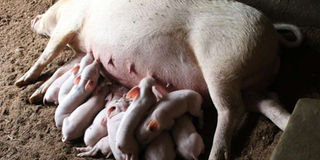If you feed your pigs garbage waste, then prepare for diseases

Some of the pigs at the Meru Technical Training Institute Farm. To attain requisite slaughter weights, pigs must consume food waste in larger quantities daily compared to commercial pig rations. PHOTO | PHOEBE OKALL | NATION MEDIA GROUP
What you need to know:
- Waste harbours diseases like pig cholera, foot and mouth and African swine fever.
- While the farmer has perfected the habit, he has to deal with challenges that include diseases associated with the contaminated food.
- Pigs are omnivorous and will therefore feed on anything they come across, that is grass, nuts, berries and insects.
- A pig being a monogastric animal, a lot of what is consumed is not properly digested as in the case of ruminants. This affects its manure and slurry as it often contains disease-causing microorganisms such as Escherichia coli, salmonella, campylobacter, yersinia, cryptosporidium and giardia.
Pigs are one of the most popular animals for the modern farmer as they are easy to manage, have a fast growth rate, convert feed to meat better and do not require much space.
However, in bid to save costs especially on commercial feeds, which are the best for pigs, some farmers are turning to food waste collected from garbage sites in urban centres.
Patrick Kirimi, a pig farmer in Tharaka Nithi County, makes pre-dawn rounds at garbage sites with gunny bags or buckets collecting food waste.
The farmer mainly searches for fruit peels, egg shells, bones, ugali and any other kitchen waste like vegetables and bread.
“Once I collect the garbage, I sort it, separating fruit peels from cooked kitchen waste. I then dry the cooked waste by spreading it in the sun and at times cook it if meat is present,” Kirimi says, attributing the practice to high cost of feeds.
However, while the farmer has perfected the habit, he has to deal with challenges that include diseases associated with the contaminated food.
“Most of the times the waste isn’t fresh as some households store it up to four five days and by the time I collect it, it is already decomposing,” Kirimi says.
Ronald Kimitei, a livestock production officer at Egerton University, says food waste in its raw form, and especially meat, contains harmful pathogens that include salmonella, campylobacter, trichinella and toxoplasma.
The waste harbours diseases like pig cholera, foot and mouth disease, African swine fever and swine vesicular that may also spread to people or other livestock.
Pigs are omnivorous and will therefore feed on anything they come across, that is grass, nuts, berries and insects. Thus, they harbour a wide range of parasites and diseases that can be transmitted to humans.
LIMITS PIG PERFORMANCE
“Food waste, preferably that fresh from the kitchen should be re-cooked or boiled at 100°C for at least 30 minutes whilst thoroughly agitating it to ensure that the temperature is maintained throughout the cooking container to curb any risk.”
While many farmers use the food waste to cut costs, Kimitei notes that the low nutritional value of the feeds and attendant diseases leads to high cost of production.
“Compared to the convectional commercial feed in terms of nutritional value, food waste has low dry matter content, which lowers nutrient intake and limits pig performance.”
Thus, to attain requisite slaughter weights, pigs must consume food waste in larger quantities daily compared to commercial pig rations.
Not every waste is good for the pig and especially that coming from the garbage pit as the nutritional component of such feeds is chemically unstable due to degradation that starts to happen hours after the food has been discarded, according to Kimitei.
“Food waste sorted out from garbage dumps should never be fed to pigs since its origin cannot be ascertained. Apart from lowering nutrient content of food, spoilage or rotting, it introduces harmful toxins that lower pig performance or cause health complications.”
A pig being a monogastric animal, a lot of what is consumed is not properly digested as in the case of ruminants. This affects its manure and slurry as it often contains disease-causing microorganisms such as Escherichia coli, salmonella, campylobacter, yersinia, cryptosporidium and giardia.
“One possible way of eliminating the microorganisms in pig manure and slurry is by composting. Proper composting at a temperature of at least 55°C for a minimum of 15 days with regular turning can yield safer fertiliser,” says Kimetei.
As a farmer, one may not have the assurance that the recommended composting conditions have been met.
“Therefore, as such it is not wise to use pig manure and slurry on food crops that come into direct contact with the soil such as cabbages, potatoes and carrots,” Kimitei advises.





